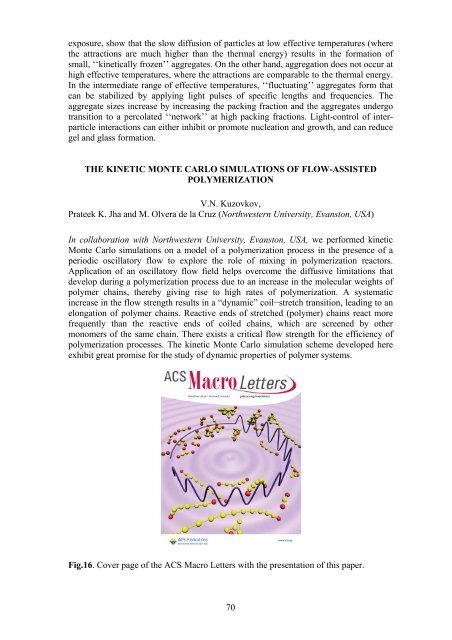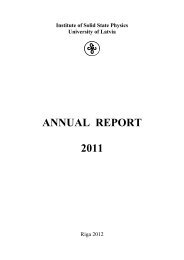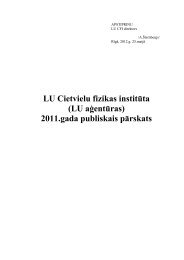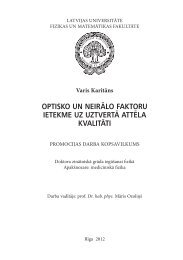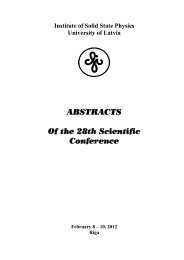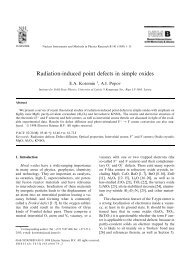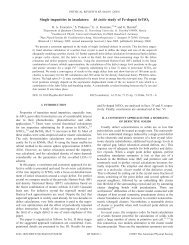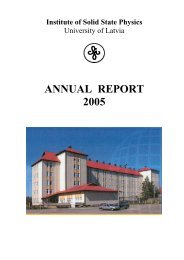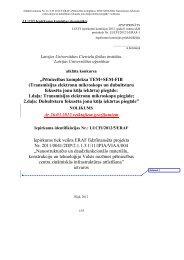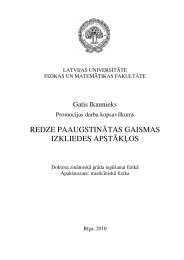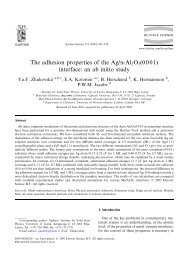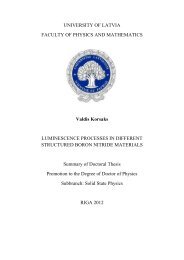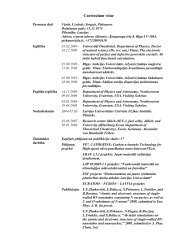Annual Report 2012 - Latvijas Universitātes Cietvielu fizikas institūts
Annual Report 2012 - Latvijas Universitātes Cietvielu fizikas institūts
Annual Report 2012 - Latvijas Universitātes Cietvielu fizikas institūts
Create successful ePaper yourself
Turn your PDF publications into a flip-book with our unique Google optimized e-Paper software.
exposure, show that the slow diffusion of particles at low effective temperatures (where<br />
the attractions are much higher than the thermal energy) results in the formation of<br />
small, ‘‘kinetically frozen’’ aggregates. On the other hand, aggregation does not occur at<br />
high effective temperatures, where the attractions are comparable to the thermal energy.<br />
In the intermediate range of effective temperatures, ‘‘fluctuating’’ aggregates form that<br />
can be stabilized by applying light pulses of specific lengths and frequencies. The<br />
aggregate sizes increase by increasing the packing fraction and the aggregates undergo<br />
transition to a percolated ‘‘network’’ at high packing fractions. Light-control of interparticle<br />
interactions can either inhibit or promote nucleation and growth, and can reduce<br />
gel and glass formation.<br />
THE KINETIC MONTE CARLO SIMULATIONS OF FLOW-ASSISTED<br />
POLYMERIZATION<br />
V.N. Kuzovkov,<br />
Prateek K. Jha and M. Olvera de la Cruz (Northwestern University, Evanston, USA)<br />
In collaboration with Northwestern University, Evanston, USA, we performed kinetic<br />
Monte Carlo simulations on a model of a polymerization process in the presence of a<br />
periodic oscillatory flow to explore the role of mixing in polymerization reactors.<br />
Application of an oscillatory flow field helps overcome the diffusive limitations that<br />
develop during a polymerization process due to an increase in the molecular weights of<br />
polymer chains, thereby giving rise to high rates of polymerization. A systematic<br />
increase in the flow strength results in a “dynamic” coil−stretch transition, leading to an<br />
elongation of polymer chains. Reactive ends of stretched (polymer) chains react more<br />
frequently than the reactive ends of coiled chains, which are screened by other<br />
monomers of the same chain. There exists a critical flow strength for the efficiency of<br />
polymerization processes. The kinetic Monte Carlo simulation scheme developed here<br />
exhibit great promise for the study of dynamic properties of polymer systems.<br />
Fig.16. Cover page of the ACS Macro Letters with the presentation of this paper.<br />
70


